Trendy Cat House Designs for Stylish Homes
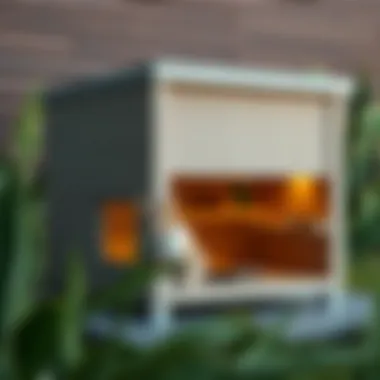
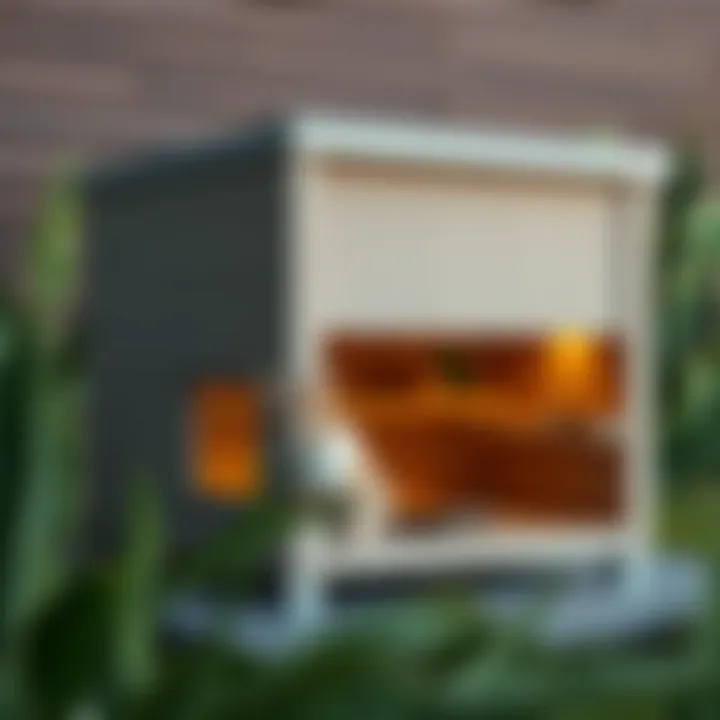
Intro
The world of pet care has evolved, shaking off traditional notions of mere functionality in favor of innovative designs that blend seamlessly with modern aesthetics. Cat houses have stepped into this landscape, transforming from simple shelters to striking pieces of art that reflect both the owner's style and the cat's needs. This transition isn't just about keeping a feline friend cozy; it's about reshaping how we view our living spaces and the role our pets play within them.
Today’s pet owners tend to seek options that speak to their sense of design while taking care of their pets' comfort and well-being. By fusing creativity with practicality, designers are crafting delightful habitats for cats that are as much about form as they are about function. The journey through this article will explore key components of contemporary cat house design, materials employed, and how these solutions meet both pet comfort and owner satisfaction. We will also explore how integrating these stylish structures into the home can enhance interior decor without compromising the needs of our furry companions.
The Evolution of Cat House Design
The design of cat houses has traveled a remarkable path from rudimentary shelters to sophisticated structures that cater to the needs of our feline companions. Understanding this evolution is critical, as it provides insight into how we’ve adapted our living environments to fulfill the emotional and physical requirements of cats. This journey illustrates not just shifts in aesthetics, but also changes in our perceptions of what constitutes a suitable habitat for pets.
Historical Perspectives
In ancient times, the concept of a cat house was far simpler. The Egyptians revered cats, often allowing them to roam freely within their homes, creating their own places to hide or rest. Simple boxes or baskets made from woven materials served as basic shelters. These rudimentary designs prioritized utility over style. In Europe, during the Middle Ages, cats were often left to fend for themselves in barns and attics, with little regard for dedicated spaces.
As time passed, the introduction of new materials, such as wood and later, metals, provided opportunities for more durable and elaborate designs. The Victorian era marked a turning point, with an increase in pet ownership and a shift towards integrating pets into family life. Structures began to take on a more ornamental nature. People started to consider aesthetics alongside functionality.
Modern Influences
Fast forward to the present day, the landscape of cat house designs has transformed dramatically. Influences from modern architecture, a surge in environmental awareness, and a deeper understanding of feline behavior have all contributed to innovative cat houses.
Key factors influencing modern designs include:
- Urban Living: In smaller apartments, compact and multi-functional designs are increasingly popular. Cat houses are often crafted to fit seamlessly into furniture, offering cozy nooks without sacrificing living space.
- Sustainability: Eco-friendly materials, such as reclaimed wood and non-toxic fabrics, have gained traction among conscientious pet owners. There’s a growing emphasis on creating products that not only serve our pets but also respect our planet.
- Style Trends: The influence of interior design trends has led to cat houses resembling chic furniture pieces, rather than standalone structures. Materials and colors are chosen to complement the home, integrating deeply with the overall decor.
The evolution of cat house designs reflects our changing attitudes toward our pets and their places in our lives. The innovative structures of today address not just practicality but also the psychological needs of cats, ensuring they have safe and stimulating environments to thrive in within our homes.
Functional Considerations
In the realm of cat house design, functionality is king. Cat houses must provide not just shelter but also cater to the innate instincts of cats, promoting their comfort and well-being while being seamlessly integrated into a home’s aesthetic. Understanding the functional considerations is crucial; it allows pet owners to make informed decisions that ultimately enhance the lives of their feline companions. From spacious napping nooks to clever safety features, these considerations play a pivotal role in ensuring that both cats and owners are satisfied.
Size and Space Requirements
When it comes to size, one size certainly doesn’t fit all. Each cat has its own personality, and, therefore, its own unique space requirements. A shy cat might flourish in a snug little cubby, whereas a more adventurous feline may appreciate a sprawling area to roam. It’s important to consider the following:
- Cat Size: Larger breeds like Maine Coons need ample room to move about comfortably. At the same time, smaller or younger cats can thrive in compact designs.
- Placement: Where you plan to put the cat house matters too. In a small studio apartment, a sleek design that fits snugly in a corner can do wonders. Alternatively, a multi-level house could be more suitable for larger spaces.
- Adaptability: Keep in mind the future. Kittens grow quickly, and a house that accommodates their growth can save you the hassle of frequent upgrades.
Remember, just like Goldilocks, a cat doesn’t want it too big or too small; it wants a house that's just right. Having several spaces can provide both exploration and security in one go.
Safety Features
Safety is a top priority in any home, especially one shared with pets. A well-designed cat house needs to minimize risks while maximizing comfort. When thinking about safety features, consider integrating the following elements:
- Non-Toxic Materials: Many materials look inviting but could pose risks. Selecting components that are free of harmful chemicals ensures a healthy habitat.
- Sturdy Construction: Cats can be athletes, often jumping from heights or climbing with abandon. A house that can withstand their antics is key. Ensure that it is well-built and has no sharp edges or small parts that could lead to choking.
- Ventilation: Proper airflow keeps the space comfortable. Stale air can lead to issues, particularly if humidity gets trapped inside. Look for designs that allow for airflow between compartments.
- Stable Base: A house that wobbles or tips over could easily frighten a cat. Ensure the design has a stable base, particularly for taller structures.
"Creating a safe environment isn't just about protection; it's about giving our pets the freedom to express their natural behaviors without fear."
In the end, functional considerations are not merely about aesthetics or space; they’re about crafting an environment that empowers cats. These aspects will not only influence how cats interact with their space but also serve to deepen the bond between pet and owner. With the right size and well-thought-out safety features, a cat house can transform into a cherished home base for adventures, naps, and relaxation.
Material Choices in Cat House Design
Selecting the right materials for a cat house is a fundamental consideration that can dramatically influence both the comfort of the feline and the aesthetic appeal for the owners. The material choices not only reflect on the structure's durability but also play a crucial role in ensuring the well-being of the cat residing inside. When delving into modern cat house designs, understanding materials becomes imperative for pet owners who wish to curate a living environment that balances practicality with style.
Natural Materials
Natural materials tend to offer a warm and inviting atmosphere, reminiscent of the outdoors. Wood is a prime example—often used for its durability and aesthetic charm. A cat house made of cedar or pine can be pleasant for both cats and humans, providing a tactile experience that synthetic materials simply can't match. Moreover, natural wood is less likely to emit harmful chemicals, reducing potential health risks associated with artificial materials.
Another natural favorite is bamboo. Its strength and flexibility create a lightweight but sturdy option for cat houses, while also being visually appealing. When well-crafted, bamboo can bring an air of elegance to any home, serving not just as a cat shelter but as a stylish piece of furniture.
"Choosing natural materials fosters a healthier environment for pets, emphasizing safety and comfort—a priority for the conscientious pet owner."
Eco-Friendly Options
As sustainability becomes a focal point in modern design, eco-friendly materials are gaining popularity in cat housing. Options such as recycled plastics or sustainably sourced wood are not just good for the planet but can also provide superior durability. These materials often come with certifications, ensuring that their production does not involve harmful practices that could damage the ecosystem.
Furthermore, biodegradable materials like hemp and recycled cardboard have a lower impact on the environment. While they might not always have the longevity of traditional materials, they present a viable option for cat houses designed to be cost-effective and environmentally sound. For pet owners who are passionate about reducing their carbon footprint, these eco-friendly choices resonate well and align with their values.
Durability and Maintenance
A cat house needs to withstand the wear and tear of daily life, especially for active felines. Materials selected must promise durability while being easy to maintain. For instance, while wood is appealing, factors like varnish and sealants should be considered to protect against moisture and scratching. On the other hand, metal often provides robust protection against chewing and bad weather, making it an excellent choice for outdoor cat houses.
Maintenance should not be a burden. Options like faux leather or wipeable surfaces can simplify cleaning, allowing for quick upkeep without compromising style. Regular cleaning routines are essential to maintain hygiene and to keep the space inviting for the cat. Ultimately, the choice of materials should weigh both longevity and ease of maintenance, ensuring that the cat house remains a safe haven for the pet owners and their beloved companions.
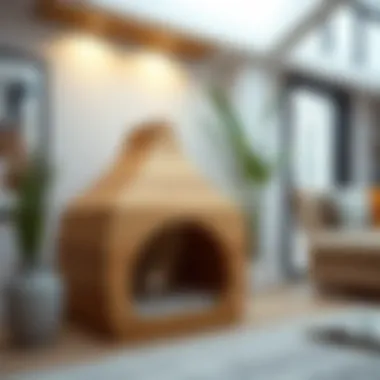
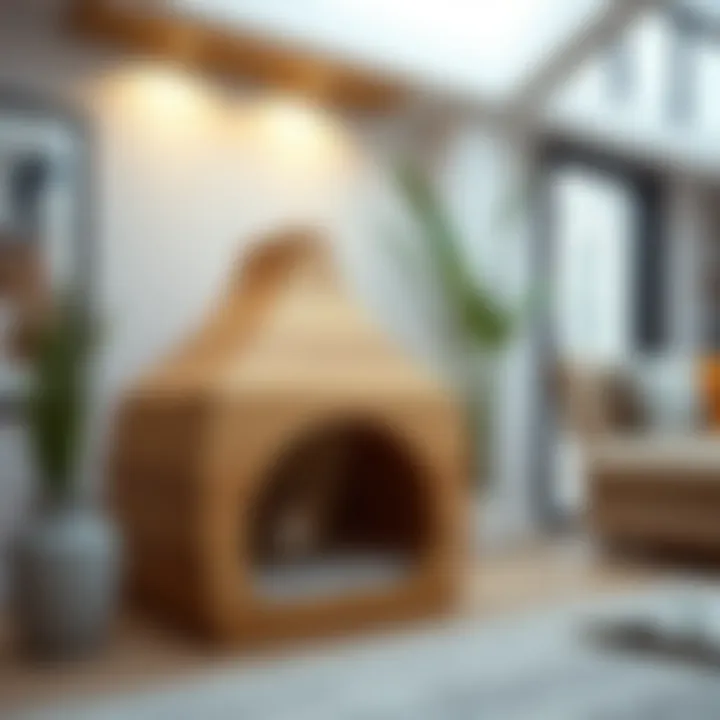
Design Inspirations
When it comes to cat house design, inspiration is the bedrock of creativity and innovation. It shapes not just the aesthetics but also the functionality and emotional connection between pet and owner. A well-chosen design can enhance your living space while catering specifically to the needs of your feline friend. Thus, understanding the nuances of design inspirations can elevate both the home environment and the comfort of your pet.
Scandinavian Minimalism
Scandinavian minimalism embodies simplicity paired with elegance. This design aesthetic is characterized by clean lines, natural materials, and functionality. Cat houses inspired by this style often utilize light-colored woods, such as birch or pine, to maintain a bright and airy feel.
Benefits of Scandinavian Design:
- Space Efficiency: The compact nature of most Scandinavian designs makes it easier to integrate cat houses into smaller living spaces without overwhelming the decor.
- Calming Aesthetics: The neutral palette creates a harmonious environment, encouraging tranquility not just for your pets but for you as well.
Considerations:
- Ensure that the materials used are safe and non-toxic for your pets. Opt for untreated woods or organic finishes to avoid harmful chemicals.
- Look for options that incorporate multiple functionalities, such as a perch that doubles as a scratching post.
Industrial Chic
Industrial chic is another fascinating approach to cat house design. Drawing inspiration from warehouses and factories, this style mixes raw materials and rustic finishes, showcasing the beauty in imperfection. Think of rough woods, exposed metals, and fabrics that nod toward a more rugged lifestyle.
Advantages of Industrial Aesthetic:
- Durability: Materials such as metal and sturdy wood can resist wear and tear from playful paws. This makes them a wise investment for active cats.
- Unique Character: Each piece often has its own story, whether it's reclaimed wood or upcycled materials, creating a great conversation starter in your home.
Considerations:
- Look for smooth edges to prevent any injuries when your cat is jumping on and off. Sharp corners and rough surfaces should be avoided.
- Ensure that the design has sufficient ventilation and comfort for your cat to feel secure in its space.
Whimsical Styles
For those who appreciate a playful touch, whimsical styles offer an imaginative escape. These designs often feature unusual shapes and bright colors, turning a cat house into a whimsical piece of art that livens up the room.
Key Features of Whimsical Designs:
- Creativity: Think of cat houses shaped like castles, rocket ships, or even trees, sparking joy not only for your feline but for all house occupants.
- Engagement: Such designs can stimulate your cat's curiosity and playful nature, as they often feature tunnels, hideouts, and climbing areas.
Considerations:
- While aesthetics are important, ensure that these structures remain comfortable and safe. Assess padding for edges and the stability of height.
- Materials should be easy to clean, as colorful fabrics may attract fur and dirt, thus compromising hygiene.
Integrating Cat Houses into Home Decor
Integrating cat houses into home decor isn't just about providing a cozy nook for our furry friends; it’s about creating a harmonious escape that resonates with the overall aesthetic of our living spaces. The growing understanding of our pets' emotional and physical needs places an emphasis on the importance of choosing cat houses that align with personal style. It’s all about finding that sweet spot where functionality meets form, thus enhancing our homes both practically and visually.
Having a cat house that merges seamlessly with your decor serves multiple benefits. Firstly, it encourages acceptance and use. A stylish cat house that complements your interior makes it more likely that you will want to showcase it rather than hide it away in a corner. When the designs are as pleasing to the eye as they are practical, both you and your feline can enjoy your space together.
Moreover, cat houses are not just passive structures; they can serve as crucial components in enriching your cat's life. A thoughtfully integrated cat house contributes to a more stimulating environment. Consequently, this kind of investment can profoundly impact your cat’s wellbeing — providing them with a safe place to retreat and observe their surroundings.
Complementing Interior Style
When selecting cat houses, it's vital to consider how they interact with the existing decor. Whether your style is vintage chic, ultra-modern, or somewhere in between, the right cat house can act as a statement piece. Think about colors, materials, and even shapes that resonate with your design choices. A cat house made from natural wood can add warmth to a minimalist space, while a sleek, modern structure may enhance an industrial setting.
Let’s highlight a few tips to help you choose:
- Color Matching: Look for cat houses in colors that echo the palette of your room. A mint green cat house in a pastel-themed room ties the whole space together.
- Material Harmony: Leather, wood, or even metal can be utilized to express the vibe of your space. For example, a polished wooden house can fit well in a rustic-style living room.
- Shape and Design: A geometric cat house can add an artistic vibe to contemporary spaces, whereas a cozy dome-shaped house might suit a softer, more traditional ambiance.
Spatial Arrangement
Considering the spatial arrangement is another fundamental aspect of integrating cat houses into home decor. The location and layout of the cat house should foster both ease of access for the feline and coherence within your home’s flow. Placing a cat house too far from common areas may deter your pet from using it, while cluttering a vital walking path can create an inconvenient living environment.
Here are steps to effectively plan the spatial arrangement of your cat's house:
- Visibility: Positioning the cat house in a noticeable area allows your cat to feel secure while also making it a natural part of the room's design without being intrusive.
- Usability: Make sure there's enough space for your cat to comfortably enter and exit the house, as well as to lounge around it. It should enhance rather than disrupt your home’s circulation.
- Accessibility: Consider incorporating small platforms or shelves nearby, which could also serve as playful additions for your cat while keeping the design cohesive.
In summary, integrating a cat house into the decor of your space should be approached thoughtfully. This integration not only enhances the aesthetic appeal but also creates an inviting atmosphere for your feline companion. It fosters an environment tailored both to your style and the comfort of your pet. The result is a space that serves the needs of both animal and owner, living together harmoniously in the same home.
Interactive and Multi-Functional Designs
The demand for pet products that both enhance the living environment and support the well-being of animals is growing. Interactive and multi-functional cat houses are at the forefront of this trend. They are not just mere shelters; they are thoughtfully designed spaces that encourage engagement, play, and comfort for felines.
The importance of these designs stems from a simple fact: cats thrive in environments that stimulate their natural instincts. Engaging structures help prevent boredom and behavioral issues while fostering a bond between pet and owner. Multi-functional designs also save space, integrating seamlessly into modern homes.
Climbing Structures
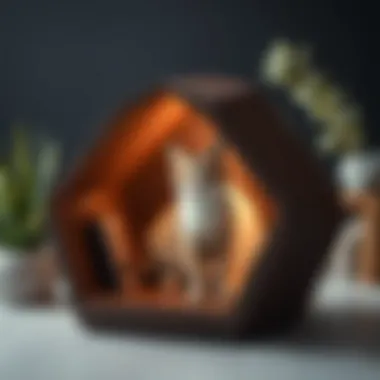
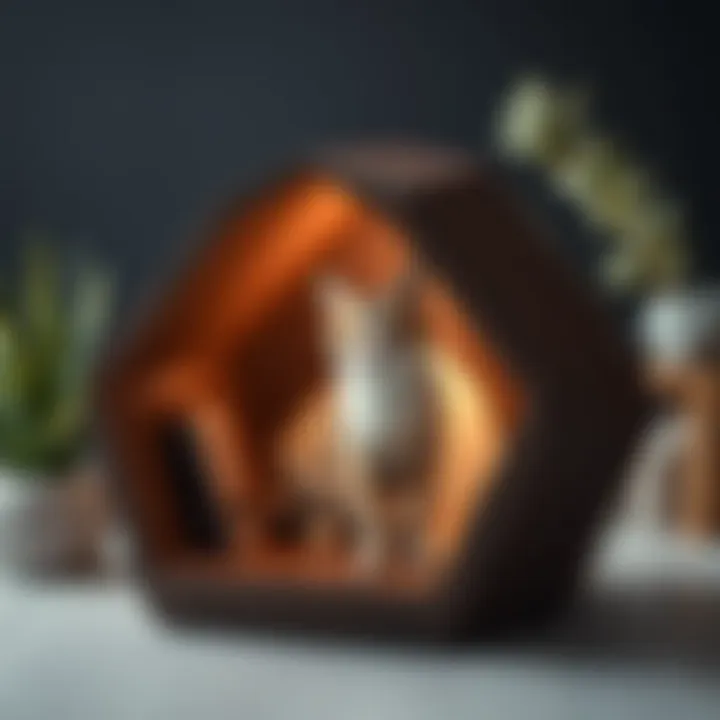
Climbing structures are a critical aspect of interactive cat houses. Cats are natural climbers, and providing vertical space allows them to explore their instincts. When designing a cat house, incorporating shelves, ramps, and perches can create an exhilarating playground. Not only does this give them the freedom to climb, but it also offers a safe vantage point where they can observe their surroundings.
Moreover, climbing can significantly contribute to their physical health. Engaging in climbing exercises helps maintain muscle tone and balance. When considering a cat house, look for designs that incorporate tree-like features or lookout points. This can transform a simple cat house into an adventurous haven.
Play Features
Incorporating play features within a cat house is an excellent way to keep our furry friends entertained. Think of small tunnels, hanging toys, or interactive puzzle areas designed to stimulate feline curiosity. Some cat houses even have built-in scratching posts or feather toys that are easy to replace, keeping the innovation fresh.
These play features are not just frivolous additions; they serve to enrich the cat's daily activities, reducing the likelihood of stress. When our cats are engaged in play, they exhibit fewer behavioral problems like scratching furniture or excessive meowing. Ultimately, interactive play spaces lead to happier, healthier pets.
Concealed Spaces
Concealed spaces within cat houses offer a sense of security that is essential for many cats. These areas, often designed as hidden compartments or cubbyholes, allow cats to retreat when feeling overwhelmed. For example, adding a small den-like space can mimic their natural instincts of seeking shelter in the wild.
Furthermore, these hidden areas contribute to an important psychological aspect—privacy. Every cat needs a personal space to feel safe. By providing a designated spot where they can curl up and relax, you are ensuring their emotional needs are met, fostering a stronger bond with your pet.
"Creating an engaging environment is key to a cat's happiness and health."
For further exploration into cat psychology and environmental enrichment, visit resources such as Wikipedia and American Veterinary Medical Association.
Custom and DIY Cat House Projects
Creating a custom and DIY cat house can be a rewarding endeavor for modern pet owners. It's not just about having a place where your cat can retreat; it's about infusing personality into the design while catering to your cat's specific needs. This section digs into the importance of going beyond ready-made solutions to craft something truly unique.
Building your cat house allows for flexibility in design, materials, and functionality. You can tailor it to fit your cat's desires, whether they love climbing, hiding, or simply lounging. Furthermore, a DIY cat house is often more budget-friendly than buying a commercial one. Though you might need time and effort, the satisfaction derived from completing a one-of-a-kind project is unmatched.
Planning and Design Tips
Planning is key before diving into any DIY project. First, consider your cat's habits. Does your feline friend prefer cozy, enclosed spaces, or do they love hanging out in open areas? Perhaps they enjoy both! Here are some important elements to consider:
- Size: Measure your available space and keep in mind how big your cat will grow. A cramped space might feel like a prison instead of a sanctuary.
- Style: Decide how you want the structure to look. Will it blend with your home decor, or stand out as a quirky conversation piece?
- Functionality: Think about incorporating multi-functional aspects, such as scratching posts, climbing surfaces, or hidden compartments.
These considerations will help you achieve a lovely balance between aesthetic appeal and practicality.
Tools and Materials Needed
Before you start hammering and nailing, make sure you have the right tools and materials on hand. Here’s a list of must-haves:
- Basic Tools: Hammer, saw, screwdriver, measuring tape, and a level.
- Materials: Plywood, untreated wood, cat-safe paint or wood stain, adhesive, screws, and maybe some fabric for added comfort.
- Optional Extras: Faux fur for cozy interiors, sisal for scratching posts, and perhaps fun embellishments.
Collecting these items ahead of time keeps the process smooth and uninterrupted.
Step-by-Step Construction Guide
This part is where the magic happens. Following a step-by-step approach makes the building process straightforward. Here’s a simplified guide to kick things off:
- Design Your Blueprint: Sketch out your structure on paper, noting the size and important features.
- Cut Your Materials: Use your saw to cut the wood according to your design specifications. Remember to wear safety goggles!
- Assemble the Skeleton: Start with the base, attaching side panels and securing them with screws. Ensure it is sturdy and stable.
- Add Features: Integrate shelves, scratching surfaces, or hiding spots as per your design.
- Finishing Touches: Sand down rough edges for safety. Apply any finishes or paint, allowing proper drying time.
- Add Soft Furnishing: Place some cozy bedding inside to invite your cat in.
Remember that the process may require adjustments, and that’s perfectly fine. Just take your time and let creativity shine!
"The best part of a DIY project is watching it evolve into something uniquely yours."
By taking on a custom cat house project, you not only provide your pet with a personalized space but also enhance your bond as they explore their new domain. Customization fosters creativity and ensures that your crafting endeavors fit seamlessly into your lifestyle. For more information and inspirations, check out resources such as Instructables or Pinterest.
Overall, a well-planned DIY cat house can bring joy to both you and your feline friend.
Trends in Cat House Design
The realm of cat house design is ever-evolving, reflecting broader societal shifts and the changing perceptions about what it means to be a modern pet owner. In recent times, cat houses have morphed from simple shelters into thoughtfully designed elements that cater not just to cats, but also to the aesthetics of the home they're placed in. This section delves into two pivotal trends that are shaping the industry: sustainability and smart technology integration.
Sustainability
Sustainability isn't just a buzzword; it's a profound paradigm that influences how we design cat homes today. The importance of sourcing sustainable materials cannot be overstated, given the growing awareness of environmental impacts.
- Natural Choices: Many contemporary cat houses now incorporate materials such as bamboo and recycled wood, which boast durability and a reduced carbon footprint. Bamboo, for instance, grows rapidly and requires minimal resources, making it an ideal choice for both pet owners and the planet. Choosing materials like this reflects an owner's commitment to environmental stewardship.
- Eco-Friendly Practices: Beyond materials, many manufacturers are adopting eco-friendly practices in their production processes. This includes using non-toxic adhesives and finishes that won’t harm pets. Such considerations ensure that the spaces in which our furry friends reside are safe and healthy.
"Investing in sustainable cat houses is not merely a trend; it’s a step towards a responsible future, where our choices make a tangible difference in the environment."
- Recyclable Designs: More designs now star features that allow for disassembly, making them easier to recycle at the end of their lifecycle. A cat house that can be returned to the earth, in a way, is a design that speaks volumes about forward-thinking.
Balancing aesthetics with sustainability means finding products that not only look good but also support our commitment to the planet. For pet owners, this trend aligns closely with their own values, marrying the love for pets with a deeper concern for the environment.
Smart Technology Integration

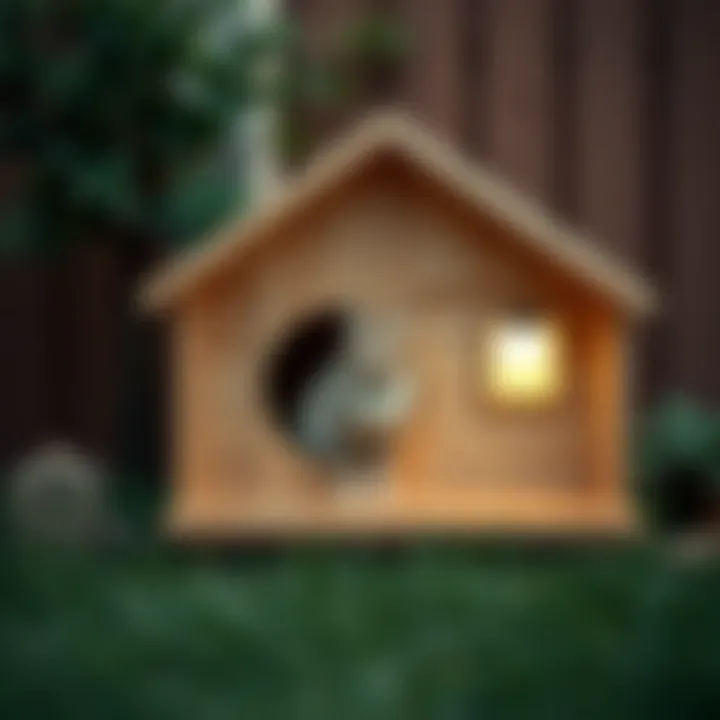
As technology permeates every facet of life, the world of cat houses is catching up, integrating smart features that offer convenience and enhance the relationship between pets and their owners. Smart technology in cat houses is about more than just gadgets; it’s about creating thoughtful solutions that cater to the modern lifestyle.
- Temperature Control: Some of the latest offerings include heated floors or cooling pads controlled by smartphone apps. This attention to comfort ensures that regardless of weather, the feline can enjoy a cozy environment. With a quick tap on their smartphone, owners can check and adjust their cat’s comfort settings.
- Environmental Monitoring: Smart cat houses may also feature sensors that monitor air quality or humidity levels, alerting owners when conditions aren’t ideal. This tech can be beneficial not just for cats but for overall home environments, making it a dual-purpose investment.
- Automated Features: Another exciting integration is automated feeders or interactive toys that can engage cats while their owners are away at work. This reduces separation anxiety and provides mental stimulation, which is particularly crucial for indoor cats.
- Home Automation Compatibility: Many smart cat houses can link up with existing home automation systems. This means owners can incorporate specific routines or alerts, like reminders to check if the kitty has enough litter or food. It speaks to the convenience-driven lives of modern pet owners who want to remain connected to their pets even when they are physically absent.
The embrace of smart technology serves to reinforce our relationship with our pets, emphasizing accessibility while catering to their needs. Ultimately, these trends push the boundaries of traditional cat house designs, ushering in an era where function meets finesse.
Psychological Aspects of Cat House Design
Understanding the psychological aspects of cat house design is crucial for creating spaces that not only look appealing but also cater to the emotional and behavioral needs of felines. Cats are more than mere pets; they are sentient beings with specific instincts and requirements. An appropriately designed cat house can act as a sanctuary for them, allowing them to feel secure, comfortable, and engaged. The design of such spaces influences their well-being and can even affect their behavior in their home environment.
Creating Safe Havens
To create a safe haven, one must consider various elements that contribute to a cat's sense of security. First and foremost, the layout of the cat house should offer nooks and crannies where the cat can retreat. For instance, a multi-level design with concealed spaces mimics the climbing and hiding behavior cats exhibit in the wild. This type of environment can reduce stress and anxiety, providing them a cozy, secluded spot to curl up when they need a break from the bustle of home life.
Incorporating soft materials like fleece or cotton can enhance comfort and encourage the cat to use the space. The house should be well-ventilated and free from any hazards. Avoid sharp edges or tiny crevices where claws might get snagged.
It's also vital to ensure that the cat house’s location is ideal. Cats often prefer elevated spots—they like to observe their surroundings from above. Thus, placing the structure in a corner or on a shelf could create a perfect vantage point for them. In addition, a warm light source nearby can make this sanctuary more inviting, transforming it into a true haven.
"A cat house should feel like a warm hug, a place of safety to which they can retreat and unwind."
Encouraging Natural Behaviors
Cats are inherently curious and playful creatures. To tap into these natural behaviors, the design of cat houses should incorporate elements that stimulate mental engagement and physical activity. Integrated scratching posts and climbing structures can encourage playful behavior, satisfying their instincts while keeping them active.
Moreover, cat houses that feature interactive components such as food puzzles or toys integrated into the structure can also enrich their experience. This kind of stimulation is crucial to keeping them mentally agile and preventing boredom. Simple designs that allow for play can make a cat house more than just a shelter; it can become a bustling playground.
Lastly, consideration of the scents in and around the cat house can also entice and comfort the feline. Using materials that can hold or enhance natural scents, such as wood or certain fabrics, makes the space feel cozier. It provides a sense of familiarity, much like the way cats mark their territory with their scent.
In sum, focusing on these psychological aspects in the design of cat houses enriches a cat's life and nurtures its natural instincts, cementing a stronger bond between the pet and its owner. By creating a designated area that feels safe and encourages healthy behaviors, modern pet owners can foster tranquility in their homes.
Selecting the Perfect Cat House
Choosing the right cat house isn’t just a whim; it speaks volumes about understanding your feline’s needs and blending them with your living space. There’s more to this selection process than simply picking a cute design. Every detail matters—sometimes it’s a matter of comfort, other times it is about aesthetics or even the lively personality of your furry friend.
Assessing Your Cat’s Preferences
Each cat has its idiosyncrasies, and understanding these can make all the difference in selecting a suitable cat house. Here are some key considerations:
- Size and Space: Does your cat like to curl up in tight spots, or does it prefer sprawling out? Kittens often enjoy snug spaces while larger cats may require room to lounge.
- Material Sensitivity: Furball might turn its nose up at certain materials. For instance, some cats favor plush surfaces, while others are a bit more rigorous, sticking to wooden or synthetic options.
- Hideaways vs. Open Spaces: Some cats are natural explorers, and they love to be in the thick of things. Others are more introverted and need a cozy nook where they can retreat from the hustle and bustle.
Understanding this can drastically affect your cat’s overall contentment. - Height Preference: Cats are creatures of instinct, often seeking vertical spaces to feel safe. Look for a design that allows climbing or has multiple levels.
In this regard, spending time observing your cat can illuminate what it truly prefers.
Understanding Your Home Dynamics
The interaction between your cat house and your home environment isn’t just about placement; it's about harmony. Here are vital points to ponder:
- Space Availability: How much room can you allocate for a cat house? A sprawling mansion of a cat house may feel a tad out of place in a snug apartment.
- Interior Style: Whether you lean towards modern minimalism or a more eclectic decor, the cat house should complement your home rather than clash with it. Choosing colors and designs that resonate with your home can enhance both your decor and your cat’s comfort.
- Household Activity Levels: Consider how busy your household is. If you have a bustling family or frequent guests, you might choose a design that provides your cat privacy, away from distractions.
- Location Considerations: Is the chosen location in a quiet corner, or close to foot traffic? Cats, being territorial, enjoy having their own space where they can observe without being disturbed.
Incorporating these elements thoughtfully creates a space that feels cohesive and nurturing, not just for your cat but for the whole family. By reflecting on your cat’s interactions and your home dynamics, you're more likely to end up with a cat house that becomes a treasured retreat for your pet.
Budget Considerations for Cat House Design
Setting a budget for cat house design might seem trivial at first glance, yet it holds significant implications for both homeowners and their feline companions. In today’s world, where options range from highly intricate designs to modest shelters, understanding costs can guide decisions that blend style with practicality. Establishing a sound financial framework can alleviate potential stress down the line. Not only does a budget allow for consideration of quality materials, but it also opens up avenues for innovative designs that might otherwise be overlooked. In essence, budgeting becomes a roadmap, ensuring that both owner and pet are satisfied without breaking the bank.
Cost-Effective Options
When diving into the realm of cost-effective cat house designs, it’s essential to remember that affordability doesn’t equate to a lack of quality. Here are some approaches to keep overall expenses in check while ensuring your cat’s comfort and style:
- Repurpose Existing Items: Utilize furniture that’s no longer in use. A cozy drawer or a small wooden crate can be transformed with a bit of creativity into an appealing hideaway for a cat. Simple cushions or a scrap of fabric add comfort without requiring much investment.
- Build Your Own: Going the DIY route provides an opportunity to craft something unique. Basic plans for cat houses can often be found online. Depending on the materials you choose, you can create a charming design at a fraction of retail prices. Websites like Instructables can give you guidance with step-by-step instructions.
- Look for Sales and Discounts: Keep an eye on local pet shops or online retailers for sales. Seasonal discounts can significantly lower the price, making it possible to snag something well-designed at a reasonable rate. Websites like Chewy often have promotions that are worth checking into.
"Investing in a cat house doesn’t mean you have to shell out a fortune. Creativity often leads to the best designs!"
Investment vs. Value
When considering whether to spend more on premium designs, it is crucial to differentiate between mere cost and true value. The concept of value encompasses more than just the price tag attached to an item. Here are aspects that define investment versus value:
- Longevity: A well-constructed cat house might require a higher initial investment but could outlast several cheaper alternatives. Choosing durable materials like plywood or treated wood can withstand wear-and-tear over years, providing better value overall.
- Functionality: Some designs feature multi-functional spaces or integrated toys, offering entertainment value and a place for relaxation. This dual-purpose design enhances the overall utility of the cat house, contributing to its worth in your home.
- Aesthetic Appeal: A beautifully crafted cat house can complement home decor, enhancing the space rather than detracting from it. This can add both satisfaction for you as the owner and additional value to the home’s ambiance.
Finale
As we draw this exploration of cat house designs to a close, it becomes clear that the topic is not to be taken lightly. Cat houses serve as more than mere shelters; they encapsulate a symbiotic relationship between pets and owners. The innovative structures discussed here highlight significant trends in both functionality and aesthetics, catering to the evolving tastes and lifestyles of modern pet owners.
Future of Cat House Design
Looking ahead, cat house design stands poised for an exciting transformation. With increasingly sophisticated pet products on the market, the future may hinge on a few pivotal elements:
- Sustainability: More designers are recognizing the impact of environmental responsibility. Expect cat houses constructed from recycled or sustainable materials to dominate in the near future.
- Smart Technology: The rise of smart homes fuels innovation in cat houses, integrating features like climate control, app notifications, and even health monitoring. These tech-savvy options could ensure our feline friends enjoy optimal comfort and safety.
- Personalization: As pet owners seek products that resonate with their personal style, customizable cat houses will likely gain traction. Tailoring designs to match interior decor while addressing cat comfort will create a more harmonious living environment.
- Behavioral Enrichment: Future designs may also delve deeper into psychological aspects, incorporating elements that encourage natural behaviors. Features such as scratch pads, elevated perches, and cozy hideaways can help fulfill their instinctual needs.
These advancement trends indicate a progressive shift in how we perceive pet housing. The focus will likely broaden to encompass not just aesthetics and comfort, but also the role these structures play in fostering healthy and happy lifestyles for our furry companions. Through thoughtful design, we can enhance the bond between pets and their owners while prioritizing well-being for both.







